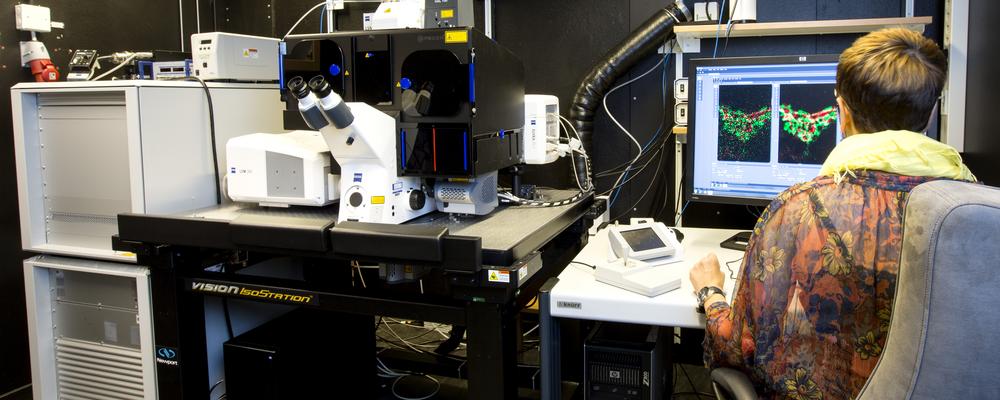
ELYRA PS.1 / LSM 780
The Carl Zeiss ELYRA PS.1 LSM 780 is a state-of-the-art inverted microscope designed for imaging in laser scanning confocal, super-resolution structured illumination (SR-SIM) and single-molecule localization (PAL-M) microscopy modes.
The ELYRA PS.1 / LSM 780 microscope frame is equipped with a dual-camera adapter that couples two electron-multiplying CCD cameras for imaging in two channels. A laser scanning module, the LSM 780, allows the specimen to be probed with point-scanning confocal microscopy. The ELYRA module contains turnkey components that allow the operator to image a selected region of the specimen to gather PAL-M images for super-resolution analysis or structured illumination SIM. Finally, the microscope is equipped with software that enables image assembly and analysis for all three imaging modes.
Laser scanning microscope LSM 780
The LSM 780 is equipped with a 32-Channel GaAsP spectral detector, which is actively cooled and has a high quantum efficiency (typically 45%). To complement this detector, two side PMTs expand the spectral working range. The group of 32 + 2 detectors allows you to reproduce spectral measurements reliably and without deviation. Since this is a parallel spectral detection design, it offers simultaneous 34-channel readout in lambda mode. Up to 10 dyes can be acquired and separated at the same time. With the new GaAsP detectors, you get up to 2x better SNR for 2x faster acquisition.
Thanks to the excellent photon-counting sensitivity of the LSM 780, it is possible to perform Fluorescence Correlation Spectroscopy (FCS) to analyze single molecule dynamics. Up to 6 channels can be used in FCS mode, providing great flexibility in your stainings and samples.
ELYRA SR-SIM and PALM illumination module
The module include a fully motorized SR-SIM imaging; five different grating frequencies for SR-SIM for optimal matching of illumination pattern to laser wavelength and objective lens; motorized exchange of gratings in multi-color SR-SIM; pattern rotation with adjustable number of angle steps (3 or 5 rotations).
The PALM illumination include a fully motorized total internal reflection (TIRF) illumination; simultaneous TIRF illumination with VIS and 405nm laser lines; individual triggering of lasers for synchronizing dye activation and illumination to camera read and transfer times; motorized TIRF angle adjustment; motorized TIRF field adjustment with three field size options.
ELYRA PS.1 / LSM 780 system characteristics
Objective lenses
- Plan-Apochromat 10x / 0.3 objective (LSM)
- Plan-Apochromat 20x /0.8 objective (LSM)
- Plan-Apochromat 40x /1.4 oil immersion objective (LSM)
- C-Apochromat 40x/1.2 water immersion (LSM / FCS)
- Plan-Apochromat 63x /1.4 oil immersion (SR-SIM / LSM)
- C-Apochromat 63x/1.2 water immersion (SR-SIM / LSM)
- Alpha “Plan-Apochromat” 100x /1.46 oil immersion (SR-SIM / PALM / TIRF)
- Alpha “Plan-Apochromat” 100x/1.57 oil immersion (PALM / TIRF)
Filters
There is one filter set GFP/mRFP/Alexa 633 shift free fluorescencefilter for ocular inspection
For super-resolution microscopy there are four filter modules on a motorized turret:
- 405 EF BP 420-480 / LP 750 SR
- 488 EF BP 495-550 / LP 750 SR
- 561 EF BP 570-620 / LP 750 SR
- 642 EF LP 655 SR
Lasers
There are four lasers for the confocal module:
- Diode laser 405 nm, CW/pulsed (30 mW)
- Argon-laser 458, 488, 514 nm (35 mW)
- DPSS-laser 561 nm (25 mW)
- HeNe-laser 633 nm (5 mW)
There are four lasers for the super-resolution module:
- Diode laser 405 nm (50 mW)
- Solid-state 488 nm (100 mW)
- Solid-state 561 nm (100 mW)
- Solid-state 642 nm (100mW)
Cameras
The camera for PAL-M is an Andor iXon 897 back-thinned EMCCD camera with a nominal quantum-yield higher than 90% and single photon detection capability that detects the generated fluorescence pattern of the individual molecules. It has 512 x 512 pixels with a 16 μm x 16 μm pixel size.
The amera for SR-SIM is an Andor iXon 885 EMCCD camera with a large field-of-view, up to 75 x 75 μm in SR-SIM (using the Plan-Apochromat 63x /1.4 oil immersion). It has 1004 x 1002 pixels with a 8 x 8 μm pixel size.